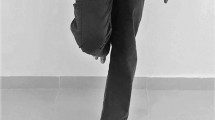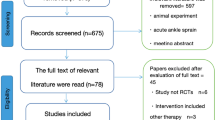Abstract
Introduction
Chronic ankle instability can impair balance, ankle range of motion, and strength. Neurofeedback training was recently used to rehabilitate musculoskeletal injuries. This study investigated the effectiveness of adding neurofeedback training to neuromuscular training on the balance, limit of stability, ankle range of motion, and strength of athletes with chronic ankle instability.
Methods
This study was three arms and a single-blind randomized control trial. Participants were 62 young male athletes with chronic ankle instability who were randomly divided into 3 groups; combination group, neuromuscular group, and control group. Eight weeks of intervention were carried out in training groups. Outcome measures were balance control, the limit of stability, ankle range of motion, and strength.
Results
The study results indicated that neurofeedback training + neuromuscular training and neuromuscular training alone improved balance, the limit of stability, ankle range of motion, and strength. Also, neurofeedback training + neuromuscular training was more effective than neuromuscular training alone in variables of dynamic balance in anterior–posterior (p = 0.031), the limit of stability in the left (p = 0.003), forward-left (p = 0.045), and backward-right (p = 0.048).
Conclusion
Considering that the improvement in dynamic balance in anterior–posterior, the limit of stability in the left, forward-left, and backward-right was greater in the combined (neurofeedback training + neuromuscular training) group compared to neuromuscular training alone, neurofeedback training can be considered as a complementary program to rehabilitation protocols for chronic ankle instability.
Trial registration
IRCTID, IRCT20211018052799N1. Registered 1 December 2021


Similar content being viewed by others
Data availability
The datasets used and/or analyzed during the current study are available from the corresponding author on reasonable request.
References
Watanabe K, Koshino Y, Kawahara D, Akimoto M, Mishina M, Nakagawa K, Ishida T, Kasahara S, Samukawa M, Tohyama H (2023) Kinesiophobia, self-reported ankle function, and sex are associated with perceived ankle instability in college club sports athletes with chronic ankle instability. Phys Ther Sport 1(61):45–50. https://doi.org/10.1016/j.ptsp.2023.02.008
Kosik KB, Hoch MC, Slone S, Bain KA, Gribble PA (2022) Health-related quality of life among patients with painful chronic ankle instability. Int J Athl Ther Train. https://doi.org/10.1123/ijatt.2022-0077
Needle AR, Tinsley JE, Cash JJ, Koeval BK, Barton JA, Howard JS (2023) The effects of neuromuscular electrical stimulation to the ankle pronators on neural excitability and functional status in patients with chronic ankle instability. Phys Ther Sport 1(60):1–8. https://doi.org/10.1016/j.ptsp.2022.12.001
Powden CJ, Hoch JM, Hoch MC (2017) Rehabilitation and improvement of health-related quality-of-life detriments in individuals with chronic ankle instability: a meta-analysis. J Athl Train 52(8):753–765. https://doi.org/10.4085/1062-6050-52.5.01
Anandacoomarasamy A, Barnsley L (2005) Long term outcomes of inversion ankle injuries. Br J Sports Med 39(3):e14–e14. https://doi.org/10.1136/bjsm.2004.011676
Tretriluxana J, Nanbancha A, Sinsurin K, Limroongreungrat W, Wang HK (2021) Neuromuscular control of the ankle during pre-landing in athletes with chronic ankle instability: insights from statistical parametric mapping and muscle co-contraction analysis. Phys Ther Sport 1(47):46–52. https://doi.org/10.1016/j.ptsp.2020.11.023
Tassignon B, Verschueren J, Delahunt E, Smith M, Vicenzino B, Verhagen E, Meeusen R (2019) Criteria-based return to sport decision-making following lateral ankle sprain injury: a systematic review and narrative synthesis. Sports Med 12(49):601–619. https://doi.org/10.1007/s40279-019-01071-3
Torp DM, Thomas AC, Hubbard-Turner T, Donovan L (2021) Biomechanical response to external biofeedback during functional tasks in individuals with chronic ankle instability. J Athl Train 56(3):263–271. https://doi.org/10.4085/197-20
Wikstrom EA, Song K (2019) Generic and psychological patient-reported deficits in those with chronic ankle instability: a cross sectional study. Phys Ther Sport 1(40):137–142. https://doi.org/10.1016/j.ptsp.2019.09.004
O’Driscoll J, Delahunt E (2011) Neuromuscular training to enhance sensorimotor and functional deficits in subjects with chronic ankle instability: a systematic review and best evidence synthesis. Sports Med Arthrosc Rehabil Ther Tech 3(1):1–20. https://doi.org/10.1186/1758-2555-3-19
Burcal CJ, Needle AR, Custer L, Rosen AB (2019) The effects of cognitive loading on motor behavior in injured individuals: a systematic review. Sports Med 1(49):1233–1253. https://doi.org/10.1007/s40279-019-01116-7
Needle AR, Lepley AS, Grooms DR (2017) Central nervous system adaptation after ligamentous injury: a summary of theories, evidence, and clinical interpretation. Sports Med 47:1271–1288. https://doi.org/10.1007/s40279-016-0666-y
Nozu S, Takemura M, Sole G (2021) Assessments of sensorimotor deficits used in randomized clinical trials with individuals with ankle sprains and chronic ankle instability: a scoping review. PM&R 13(8):901–914. https://doi.org/10.1002/pmrj.12487
Maszczyk A, Gołaś A, Pietraszewski P, Kowalczyk M, Cięszczyk P, Kochanowicz A, Smółka W, Zając A (2018) Neurofeedback for the enhancement of dynamic balance of judokas. Biol Sport 35(1):99–102. https://doi.org/10.5114/biolsport.2018.71488
Shahrbanian S, Hashemi A, Hemayattalab R (2021) The comparison of the effects of physical activity and neurofeedback training on postural stability and risk of fall in elderly women: a single-blind randomized controlled trial. Physiother Theory Pract 37(2):271–278. https://doi.org/10.1080/09593985.2019.1630877
Dessy E, Mairesse O, Van Puyvelde M, Cortoos A, Neyt X, Pattyn N (2020) Train your brain? Can we really selectively train specific EEG frequencies with neurofeedback training. Front Hum Neurosci 10(14):22. https://doi.org/10.3389/fnhum.2020.00022
Li X, Zhang J, Li XD, Cui W, Su R (2020) Neurofeedback training for brain functional connectivity improvement in mild cognitive impairment. J Med Biol Eng 40:484–495. https://doi.org/10.1007/s40846-020-00531-w
Caldemeyer LE, Brown SM, Mulcahey MK (2020) Neuromuscular training for the prevention of ankle sprains in female athletes: a systematic review. Phys Sportsmed 48(4):363–369. https://doi.org/10.1080/00913847.2020.1732246
Faul F, Erdfelder E, Lang AG, Buchner A (2007) G* Power 3: a flexible statistical power analysis program for the social, behavioral, and biomedical sciences. Behav Res Methods 39(2):175–191. https://doi.org/10.3758/BF03193146
Yalfani A, Azizian M, Gholami-Borujeni B (2023) Adding neurofeedback training to neuromuscular training for rehabilitation of chronic ankle instability: a 3-arm randomized controlled trial. Sports Health. https://doi.org/10.1177/19417381231219198
Gribble PA, Delahunt E, Bleakley C, Caulfield B, Docherty C, Fourchet F, Fong D, Hertel J, Hiller C, Kaminski T, McKeon P (2013) Selection criteria for patients with chronic ankle instability in controlled research: a position statement of the International Ankle Consortium. J Orthop Sports Phys Ther 43(8):585–591. https://doi.org/10.2519/jospt.2013.0303
Kosik KB, Johnson NF, Terada M, Thomas-Fenwick AC, Mattacola CG, Gribble PA (2020) Health-related quality of life among middle-aged adults with chronic ankle instability, copers, and uninjured controls. J Athl Train 55(7):733–738. https://doi.org/10.4085/1062-6050-190-19
Herb C, Donovan L, Feger M, Blemker S, Hart J, Saliba S, Hertel J (2022) Effects of rehabilitation on joint-coupling in patients with chronic ankle instability. Sports Biomech 21(4):472–486. https://doi.org/10.1080/14763141.2020.1821758
Sierra-Guzmán R, Jiménez-Diaz F, Ramírez C, Esteban P, Abián-Vicén J (2018) Whole-body–vibration training and balance in recreational athletes with chronic ankle instability. J Athl Train 53(4):355–363. https://doi.org/10.4085/1062-6050-547-16
Perron M, Hébert LJ, McFadyen BJ, Belzile S, Regnieàre M (2007) The ability of the biodex stability system to distinguish level of function in subjects with a second-degree ankle sprain. Clin Rehabil 21(1):73–81. https://doi.org/10.1177/0269215506071288
Mentiplay BF, Perraton LG, Bower KJ, Adair B, Pua YH, Williams GP, McGaw R, Clark RA (2015) Assessment of lower limb muscle strength and power using hand-held and fixed dynamometry: a reliability and validity study. PLoS One 10(10):e0140822. https://doi.org/10.1371/journal.pone.0140822
Bronner S, Agraharasamakulam S, Ojofeitimi S (2010) Reliability and validity of electrogoniometry measurement of lower extremity movement. J Med Eng Technol 34(3):232–242. https://doi.org/10.3109/03091900903580512
Van Reijen M, Vriend I, Zuidema V, Van Mechelen W, Verhagen EA (2016) Increasing compliance with neuromuscular training to prevent ankle sprain in sport: does the ‘Strengthen your ankle’mobile App make a difference? A randomised controlled trial. Br J Sports Med 50(19):1200–1205. https://doi.org/10.1136/bjsports-2015-095290
Rezaei K, Nami M, Sinaei E, Bagheri Z, Yoosefinejad AK (2021) A comparison between effects of neurofeedback and balance exercise on balance of healthy older adults. J Biomedi Phys Eng. https://doi.org/10.31661/jbpe.v0i0.1203
Kim KM, Estepa-Gallego A, Estudillo-Martínez MD, Castellote-Caballero Y, Cruz-Díaz D (2022) Comparative effects of neuromuscular-and strength-training protocols on pathomechanical, sensory-perceptual, and motor-behavioral impairments in patients with chronic ankle instability: randomized controlled trial. Healthcare 10(8):1364
Solis-Escalante T, van der Cruijsen J, de Kam D, van Kordelaar J, Weerdesteyn V, Schouten AC (2019) Cortical dynamics during preparation and execution of reactive balance responses with distinct postural demands. Neuroimage 1(188):557–571. https://doi.org/10.1016/j.neuroimage.2018.12.045
Hayashi M, Mizuguchi N, Tsuchimoto S, Ushiba J (2020) Neurofeedback of scalp bi-hemispheric EEG sensorimotor rhythm guides hemispheric activation of sensorimotor cortex in the targeted hemisphere. Neuroimage 1(223):117298. https://doi.org/10.1016/j.neuroimage.2020.117298
Hammond DC (2011) What is neurofeedback: an update. J Neurother 15(4):305–336. https://doi.org/10.1080/10874208.2011.623090
Cerbezer N, Çil ET, Subaşı F (2023) The effect of neuromuscular and vestibular-ocular reflex training program on balance, isokinetic muscle strength and proprioception in people with chronic ankle instability. Foot 1(56):101992. https://doi.org/10.1016/j.foot.2023.101992
Azarpaikan A, Torbati HT, Sohrabi M (2014) Neurofeedback and physical balance in Parkinson’s patients. Gait Posture 40(1):177–181. https://doi.org/10.1016/j.gaitpost.2014.03.179
Sidhu A, Cooke A (2021) Electroencephalographic neurofeedback training can decrease conscious motor control and increase single and dual-task psychomotor performance. Exp Brain Res 239(1):301–313. https://doi.org/10.1007/s00221-020-05935-3
Hammond DC (2005) Neurofeedback treatment of depression and anxiety. J Adult Dev 12:131–137. https://doi.org/10.1007/s10804-005-7029-5
Wang JR, Hsieh S (2013) Neurofeedback training improves attention and working memory performance. Clin Neurophysiol 124(12):2406–2420. https://doi.org/10.1016/j.clinph.2013.05.020
Rosen AB, Than NT, Smith WZ, Yentes JM, McGrath ML, Mukherjee M, Myers SA, Maerlender AC (2017) Attention is associated with postural control in those with chronic ankle instability. Gait Posture 1(54):34–38. https://doi.org/10.1016/j.gaitpost.2017.02.023
Janssen KW, van Mechelen W, Verhagen EA (2011) Ankles back in randomized controlled trial (ABrCt): braces versus neuromuscular exercises for the secondary prevention of ankle sprains. design of a randomised controlled trial. BMC Musculoskelet Disord 12:1. https://doi.org/10.1186/1471-2474-12-210
Acknowledgements
The authors would like to express their gratitude to all the study participants. From this research project, another article has been published in Sports Health journal, which investigated the effect of combined exercises on plantar pressure of athletes with chronic ankle instability [20].
Funding
The authors reported there is no funding associated with the work featured in this article.
Author information
Authors and Affiliations
Contributions
Conception and design, MA and BG-B; analysis and interpretation of data, AY, MA, and BG-B; draft of article, MA and BG-B; revision and editing work critically for important intellectual content, AY and BG-B; monitoring progress, AY; final approval of the study, AY, MA, and BG-B.
Corresponding author
Ethics declarations
Conflict of interest
None. The authors declare that they have no competing interests.
Ethical approval and consent to participate
This study was conducted in accordance with the Helsinki Declaration (2008) and was approved and registered by the Bu-Ali Sina University Ethics Committee (IR.BASU.REC. 1400.037), and written informed consent was obtained from all participants prior to the study.
Consent for publication
Not applicable.
Additional information
Publisher's Note
Springer Nature remains neutral with regard to jurisdictional claims in published maps and institutional affiliations.
Rights and permissions
Springer Nature or its licensor (e.g. a society or other partner) holds exclusive rights to this article under a publishing agreement with the author(s) or other rightsholder(s); author self-archiving of the accepted manuscript version of this article is solely governed by the terms of such publishing agreement and applicable law.
About this article
Cite this article
Yalfani, A., Azizian, M. & Gholami-Borujeni, B. Neurofeedback training can increase the effectiveness of neuromuscular training on balance and limit of stability of athletes with chronic ankle instability: three arms and single-blind randomized control trial. Sport Sci Health (2024). https://doi.org/10.1007/s11332-024-01212-w
Received:
Accepted:
Published:
DOI: https://doi.org/10.1007/s11332-024-01212-w




